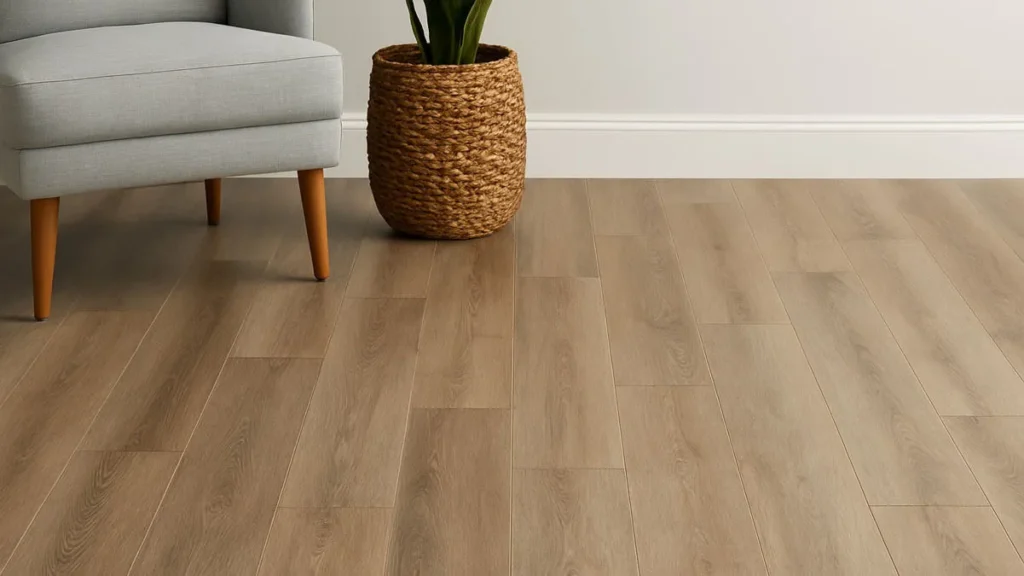What Is LVP Flooring


What Is LVP Flooring? LVP flooring stands for Luxury Vinyl Plank flooring. It is a hard surface flooring material made to look like wood or stone while being constructed from layers of synthetic materials. The product is designed to provide a balance between appearance and function. LVP flooring is commonly used in residential and commercial spaces because of its water resistance, ease of maintenance, and versatile design.
Composition and Structure of LVP
Luxury Vinyl Plank flooring is built from multiple layers. The top layer is a clear wear layer that serves as the surface shield, helping protect against daily wear and surface damage. Beneath that layer is the design layer. This is where the printed image of wood grain, stone, or other textures appears. The design layer is what gives the plank its visual identity.
Next comes the core layer, which provides the flooring with structure and firmness. Others use a rigid core, which is known as either SPC (stone plastic composite) or WPC (wood plastic composite), but some LVP products have a flexible core. Each core type has a different density and durability profile. At the base, there is usually a backing layer that provides grip and absorbs sound.These layers are merge into a single plank, that is designed to be clicked or glued into place during installation.
Available Dimensions and Surface Finishes
Vinyl plank flooring has different sizes. based on the product, widths and lengths can be different, and the thickness approximately ranges from 2 mm to 8 mm or more. The thickness can effect the product’s comfort underfoot and sound reduction abilities.
Surface finishes also be differ. Some LVP flooring comes with a smooth plain finish, but some lvp flooring are embossed to mimic real wood grain or stone surface. The finish affects both appearance and slip resistance. The wear layer can also vary in thickness, which plays a role in how long the surface resists marks, scratches, and surface changes caused by foot traffic or moving furniture.
Uses of LVP Flooring
Areas where moisture and spills are possibe the Luxury Vinyl Plank is generally installed. It is used in kitchens, laundry rooms, bathrooms, and basements. traditional hardwood flooring might be at risk of water damage at these areas. LVP’s design resists moisture from above and below, depending on the installation method and product construction.
It is also installed in living rooms, dining rooms, hallways, and offices where frequent foot traffic occurs. In commercial spaces, it is used in retail stores, medical offices, and lobbies because of its resistance to stains and the ease of cleaning. The lvp flooring can be stable in different temperatures and conditions due to its layered structure.
Installation Types and Methods
There are several installation systems for LVP flooring. One method involves floating planks, which lock together with a click-and-lock mechanism. This system is used for faster installations and it does not even require glue or nails. The planks are not attached directly they sit on top of a subfloor or underlayment.
Another type uses adhesive backing. These planks are peeled and stuck directly to the subfloor. When noise reduction is important or for smaller areas, this method is used. Glue-down installation is third option. Before placing the planks this method uses sticky spread over the subfloor. It is commonly used in commercial settings where permanent bonding is needed.
The subfloor conditions and room type determine which installation method is suitable. Some LVP products are labeled as “loose lay,” meaning they can be placed without glue or click systems if the room dimensions and plank weight allow for it.
Conditions for Proper Installation
Before placing LVP flooring, certain site conditions must be met. The subfloor must be clean, dry, and level. Debris, moisture, or uneven surfaces can affect how the planks lock or adhere. Moisture barriers are sometimes required in areas with concrete subfloors or high humidity levels.
Before installing the LVP flooring, acclimation will be recommended. The planks are placed in the room for at least 48 hours, to be installed. This step helps them adjust to the temperature and moistness of the space. It minimizes the risk of expansion or contraction after installation is complete.
After the installation, Before allowing furniture or foot traffic, LVP should be left without any distrubance for the recommended time. This period can be different on the basis of the type of installation used and the manufacturer’s instructions.
Performance Characteristics
LVP flooring is engineered to be durable. Its wear layer helps it resist surface scratches, dents, and stains. The rigid core variants are especially stable and are less likely to show pressure marks from heavy furniture. The waterproof nature of most LVP products allows them to handle spills without immediate damage. But, the completion can be still dependon the conditions of subfloor and quality of installation.
The material is generally comfortable underfoot and produces less noise than other hard flooring options. Some products include padding on the backing layer to improve sound control and cushioning. Heat resistance can also be different, but LVP can only be affected by extreme temperatures. causing fading or expansion, because of direct sunlight over long time, window coverings may be recommended for certain rooms.
Cleaning and Maintenance Guidelines
Routine maintenance of LVP flooring includes sweeping or vacuuming to remove dirt and dust. Soft bristle brooms or vacuums designed for hard floors are best. For deeper cleaning, a damp mop and pH-neutral floor cleaner may be used. It is not recommended to use steam cleaners or abrasive tools on LVP.
Spills should be wiped up quickly to keep the surface clean. Furniture should have protective pads to avoid pressure marks. Area rugs can be used in high-traffic spots, but rugs with rubber or latex backings should be avoided unless the flooring is compatible. These backings can sometimes cause discoloration over time.LVP flooring does not require waxing or sealing. The wear layer is designed to function without added treatment. If a plank becomes damaged, many styles allow individual pieces to be removed and replaced without disturbing the rest of the floor.
Environmental and Indoor Considerations
Some LVP products meet the indoor air quality standards. Indicating low emissions of volatile organic compounds (VOCs), Manufacturers can label them with certifications. These certifications can be different by area, but they are commonly observed product packaging or included in technical documents.
Disposal and recycling options also vary. Some vinyl planks are recyclable depending on the core materials and regional facilities. If removal is needed during remodeling, check the local guidelines for how vinyl products should be handled.
Read more: How Much Concrete Do I Need?
Summary of Material Attributes
What is LVP flooring? It is a layered flooring material designed to resemble natural wood or stone while offering moisture resistance and durable performance. With multiple installation options, a wide range of finishes, and uses in both homes and commercial spaces, it functions as a strong alternative to traditional flooring materials. Each component of LVP serves a role in its structure, making it suitable for areas where water exposure, high foot traffic, and ease of maintenance are priorities.

